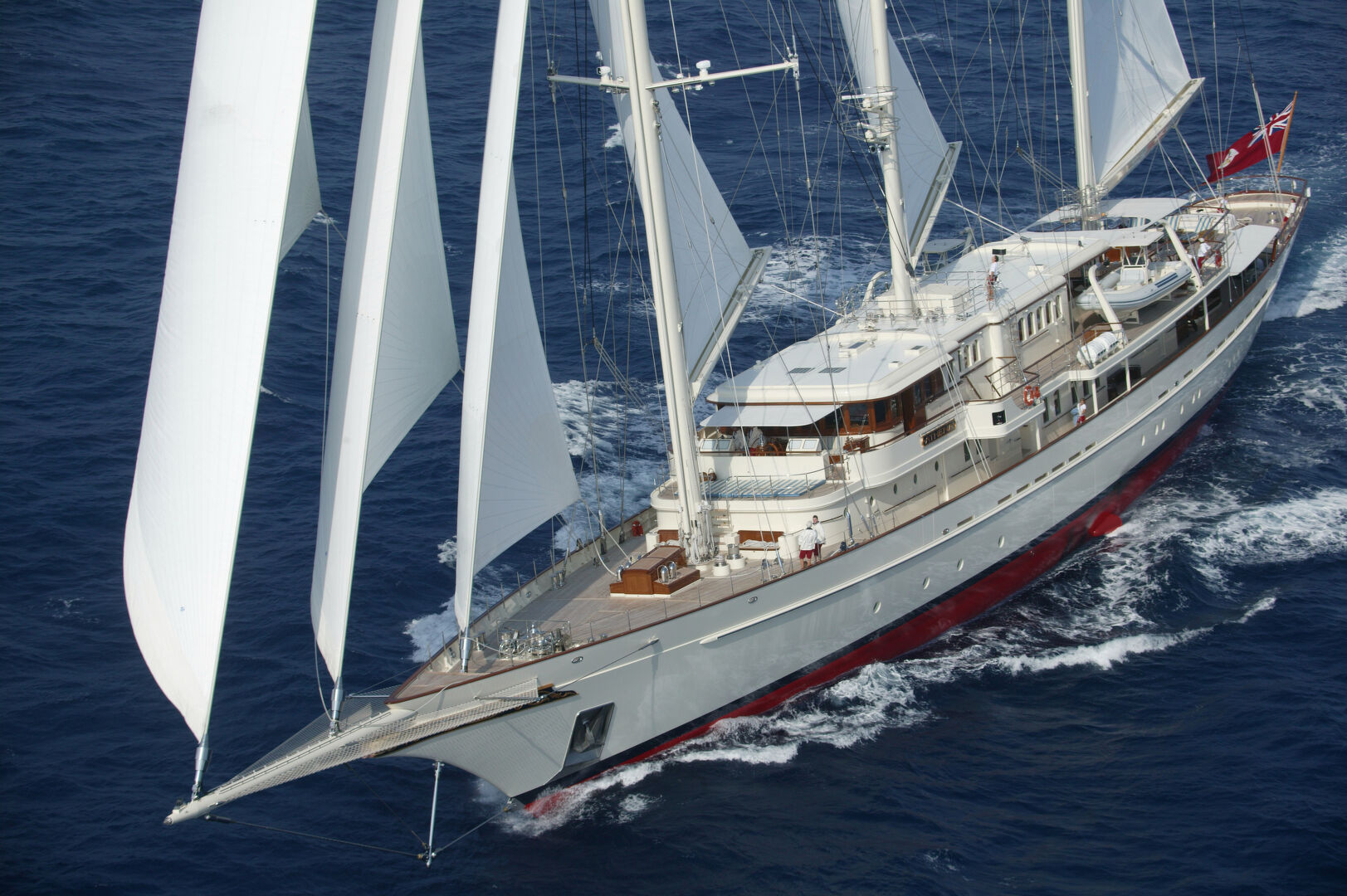A dramatic image released last year was the turning of the 81-metre hull known as Project 400 at the Royal Huisman shipyard in the Netherlands. Its immense size was startling. The delicate operation required four cranes, two on the hard and two on floating barges. At one point, half the aluminium hull was hanging over the water while the stern was still inside the build hall. 
Not surprisingly, the project has thrown up a few challenges even for Royal Huisman, accustomed as they are to building sailing superyachts. By way of comparison, Athena, their previous flagship delivered in 2004, was slightly shorter without her bowsprit and smaller in volume than Sea Eagle II. 
Discussions about a bigger boat began while Sea Eagle was still in build. These centred around the owner’s appreciation of Athena, but evolved into a more contemporary schooner design with a plumb bow and a long waterline for better performance under sail.
A year was spent on the design, engineering and construction planning before the keel was laid in June 2017. From the outset, it is was clear that the size of the project presented some logistical challenges. Royal Huisman had to first extend its main construction shed to contain the massive project, but also review its production and management procedures to ensure that the build process progressed smoothly, on budget and on schedule.
The shipyard embraced a concept known as ‘concurrent design’, a method of product development based on completing processes at the same time while involving all disciplines. A related process is ‘stage gating’, by which a project is divided into distinct stages separated by decision points known as ‘gates’. Both methodologies are commonly used in the aerospace and satellite industries with the aim of increasing time and cost efficiency while maintaining quality.
Another production improvement has been the adoption of modular skid fabrication. Instead of installing engineering components individually, the systems are assembled within a frame or ‘skid’ for plug-and-play installation.
“Skids allow us to build entire systems in parallel, test them off-site and install them as complete units,” says Julien Hogemans, production project manager at Royal Huisman. “With as many as 20 skids on this project – from fuel and fresh water to AC and entertainment system – it makes the whole installation process faster and more efficient.”
The engineers and naval architect were presented with a challenge of a different sort. Aluminium is a highly ductile metal, which makes it easier to cut and shape but more difficult to maintain longitudinal strength in an 81-metre sailing yacht where the loads from keel and rig on the hull are much higher than a motor yacht of equivalent size. 
“As a result of the wave loads, the yacht is going to flex and that includes the superstructure, so for the first time the forward section of the coachroof is glued rather than welded to the deckhouse,” says Stefan Coronel, design & engineering manager. “It means these large elements can deform independently of one another to reduce the risk of stress fractures and unwanted loads on the glass panels.” 
“With milling there’s no heat, so no shrinkage, and you can prepare the edges ready for welding instead of grinding them,” says Julien Hogemans. “We can also add a lot of details during the milling, like perforations for deck winches instead of aligning and drilling them afterwards. It basically means more accurate and efficient assembly, a bit like a flatpack from Ikea.”
Aluminium masts with carbon fibre booms and rod rigging were envisaged in the early stages of the design, but the owner later changed to carbon fibre masts and continuous Carbo-Link rigging to reduce weight and increase performance. 
Rondal also developed the weather-tight sliding doors between the main cockpit and the interior, a complex piece of engineering with four individually operated moving glass sections. The whole structure was mounted on a frame in the factory awaiting water and inclination tests (to simulate heeling under sail) by Lloyds surveyors.
Standing under the transom, the six-metre fixed keel, which took two weeks to fill with lead, provides a very tangible idea of the sheer size of Sea Eagle II. Her four-metre tall rudder – the largest ever built out of carbon composite – is fitted with sensors to measure the considerable forces acting on it. 
The interior design by Mark Whiteley is tastefully low-key and based on oak and Alpi walnut, a sustainable natural material made from reconstituted wood. For safety in a seaway, there are plenty of handrails and robust fiddles to hold on to.
With a raised pilothouse in addition to the helm stations on the flybridge, there is a formal dining room/lounge on the main deck forward where you would usually expect to find the master suite. Instead, the owner prefers to occupy a relatively modest VIP suite, one of six guest cabins all on the lower deck. The only part of the boat that was mocked-up in plywood to full size was the flybridge helm stations – a clear indication of where the owner’s priorities lie. 
This article was first featured in The SuperYacht Times newspaper. Subscribe now to receive your copy straight to your door and never miss another issue.